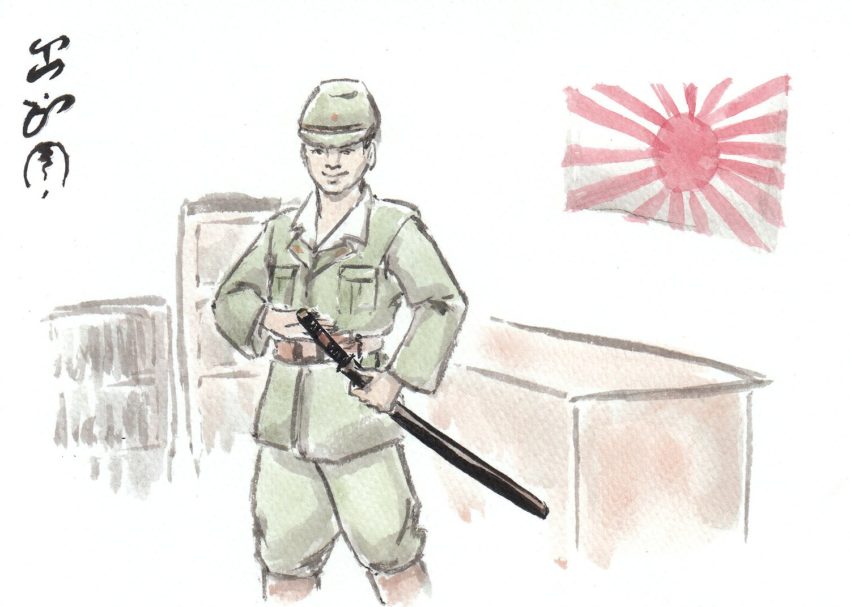Japanese military culture and history is fascinating and important to learn about, especially if you are thinking about purchasing a Japanese officer sword or becoming a collector of nihontoNIHONTO 日本刀 "Japanese sword" learn more.... Modern Japanese military officers’ swords have been made since the mid-1900s, and the shinguntoSHINGUNTO 新軍刀 "new military sword" learn more... is the most common type of mounting from the World War II period. This article will explain to you the history, types, meanings, and rules regarding Japanese officers swords and provide you with some information about their availability for collectors today.
Japanese Military Culture and History
Until 1868, Japanese military history consisted of clan warfare followed by feudal wars. After the Meiji Restoration of 1868, Japan entered the modern era, opening to western trade and influence. This led to the building of a powerful modern military.
Types of Japanese Officer Sword
Japanese military swords produced between 1875 and 1945 are referred to as guntoGUNTO 軍刀 "(modern) saber" learn more... or gendaitoGENDAITO 現代刀 "contemporary sword" learn more.... The most common style of sword mounting from this era, shingunto mounts, used machine-made blades for the most part. Some blades, however, were hand-made, using non-traditional methods. Such traditionally-made swords are gendaito or kindaito. In late 1944, two other styles of shingunto mounts were produced.
Uses, Meanings and Rules of Officer Swords
The shingunto (translated as something akin to “new military sword”), used by the Japanese Imperial Army from 1935 to 1945, symbolized rank. Manufactured at the Toyokawa Naval Arsenal and styled after the traditional slung tachiTACHI 太刀 "great sword" learn more... of the Kamakura Period, the WW2 Japanese sword was either made by modern machines, traditionally manufactured, or had been passed down from ancestors. However, most of the swords used in this period were mass-produced in factories.
During pre-World War II, and throughout the war, all Japanese officers were required to wear a sword. They were made non-traditionally and are called showatoSHOWATO 昭和刀 "Showa-era sword" learn more.... In 1937, the Japanese government began requiring the use of special stamps to distinguish these bulk-made blades from traditionally made swords. Showato are not considered to be true Japanese swords – even while outside of Japan they are beloved and collected as historical artifacts.
The katana type of shingunto, issued to officers in the Japanese Army, symbolized the samuraiSAMURAI 侍 "warrior serving a lord" learn more... tradition. Some kamikazeKAMIKAZE 神風 "divine wind" learn more... and Navy officers carried a poor quality katana in battle, while others used a traditional katana passed down from father to son. Other kinds of Japanese officer sword like the gunto and the dirk (a shorter dagger) symbolized the officers’ status, honor and pride. Therefore, you can say the Japanese swords served a ceremonial purpose, but also could be used in battle. They provided soldiers with a feeling of confidence and a connection to the past and to their ancestors. At the end of the war, these swords were at times even used in suicide attacks.
Swords Used for Actual Combat
Army soldiers used swords at many battles during World War II, such as fighting in the Burma Mandalay suburbs in 1942. The naval brigade used them in occupying the Namler airfield in Buru and when landing at Western New Guinea. These are just a few examples, and there are countless others. At the end of the war, the gunto was used for valiant fighting during many severe last-ditch battles. Again, the Japanese officer sword rarely saw true action and most still-extant examples remain reasonably intact.
After World War II, sword manufacture and sword-related martial arts were banned in Japan. Many of Japan’s historic and artistic swords ended up in the United States. After 1953, Japanese sword smiths were again allowed to work, albeit with severe restrictions. The tradition of Japanese sword making was revived, and today, there are around 250 swordsmiths working and producing swords in Japan.
Availability and Collectability of the Japanese Officer Sword
If you are interested in or considering purchasing an authentic Japanese officer sword, you should be sure that you buy it from a reputable, knowledgeable, and reliable individual or dealer. Whether you purchase one online, at a shop or show or exhibition, or from a private individual, find out as much as you can about the piece before you make a commitment.
Authentic Japanese officers’ swords are available, but there are also newer copies on the market. If it is from China or Vietnam, especially with a low price, it is probably a fake. If the sword has a traditionally-made blade, you can check to see if it is signed on the tang. Gunto that are mass-manufactured, might not be signed by smiths, although many are signed by assembly line workers. If authenticity is less important, and the overall beauty (and lower price) fit your needs, a forgery or other modern reproduction can be a perfectly acceptable blade to purchase and proudly display.
It is important to know what you are looking for before making a purchase. A World War II-era shingunto, which looks like a katana, will cost more than a World War I-era kyuguntoKYUGUNTO 旧軍刀 "old military sword" learn more... or shingunto. Swords with traditional blades will generally cost much more than swords with newer or machine-made blades. Swords from before World War I are harder still to find, and of course more expensive. (They are also more likely to be damaged or in poor shape.)
Finding out as much as you can about the sword you purchase is also great way to increase your knowledge of Japanese history and culture and your appreciation for the Japanese tradition of swords. When you hold a sword that you know was actually used in battle, you will feel a deeper connection to Japanese history and culture. Taking the time to learn about the items in your collection and their uses and meaning will make them especially precious.
Final Thoughts
If you are considering purchasing a Japanese military sword, begin by studying them and learning as much as you can. By doing your research, you will be better equipped to avoid scams and you will have a deeper appreciation for the items that you eventually purchase and collect. Becoming a collector of Japanese military swords is a thrilling endeavor, especially if you have the knowledge and information that allows you to truly appreciate your collection.

